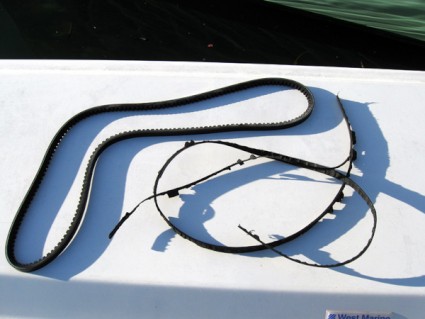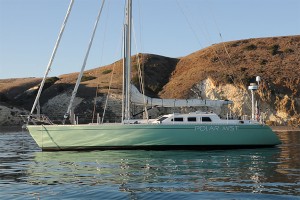
Polar Mist
04 November 2015 | Poulsbo, Washington
04 September 2015 | Salmon Bay Marine Center
26 August 2015 | Delta Boatyard
25 August 2015 | Delta Boatyard
24 June 2015 | Delta Boatyard
31 May 2015 | Delta Boatyard
16 January 2015
19 October 2014 | Seattle, Washington
25 September 2014 | Port Browning, North Pender Island
11 September 2014 | Silva Bay, Gabriola Island
26 August 2014 | Headed Out From Victoria, B.C.
23 August 2014 | Victoria's Inner Harbor
23 August 2014 | Strait of Juan de Fuca
14 August 2014 | Alberni Inlet
12 August 2014 | Effingham Island
04 August 2014 | Tofino Harbor
26 July 2014 | Westview Marina
24 July 2014 | Zabellos
18 July 2014 | Walters Cove, BC
13 July 2014 | Coal Harbor
Belt Hell
05 July 2013
Capt. Rick

We had a drive belt that must have been very bad in an earlier life. The first part of our trip from Ventura to Honolulu was great sailing in 20 to 30 kts of wind. For days, we had the double reef in the mainsail and sometimes part or the entire jib furled as we hurtled along at 8 to 10 knots in the general direction of Hawaii. (That fickle wind direction never seemed to let us point in the exact direction we wanted to go).
After several days of great sailing, we entered a calm zone that spanned about 800 nautical miles. There is a publication called the Northern Pacific Pilot Chart that covers historical weather and current data going back to the 1800’s. Historically in June, there is a 1 to 2 percent chance of a calm in this area of predominantly Northeast Trade Winds. The trade winds are what the sailors of old depended on—latitudes of good wind from a known direction that they could count on to get them to where they wanted to go. So anyway, right in the middle of the trade winds with a 1 to 2 percent chance of a calm, we completely ran out of wind for five days!
The first part of the trip showed us what a good sailing boat Polar Mist is. When we hit the calm, we found out that Polar Mist is also a great boat under power. We started up the 85-horse, 18-year-old John Deere diesel engine and started chewing up 170 miles a day. Now, we weren’t that happy to be doing it—it is noisy and makes lots of vibrations that make sailors crabby. But, it was either motor onward or roll around in glassy seas in the same place with sails slatting. I’m glad we chose to motor on….. In five days of powering, we used less than half of our 600 gallons of fuel.
On the second day of motoring, I noticed that the engine tachometer had quit working, although the diesel was running nicely with normal temperature and oil pressure. I popped down into the engine room (yes, we have an actual engine room that one can stand up in) and discovered that the drive belt for the alternator had disappeared. I found it later under the engine and you can see from the before and after photo—it was a really bad day for that belt!
The engine room was hot (98 degrees). The seas were rolly. The engine was hot (180 degrees). We can charge batteries with a high capacity alternator on the auxillary engine. To replace the belt meant removing three other belts. We decided to press on without the alternator (on our engine, the water pump has it’s own belt). In the middle of the Pacific Ocean, we chose to carry on with an engine that was running instead of fixing a minor problem and risking causing a major problem.
I’m glad we waited—we replaced the belt our first day after arriving in Honolulu. It was not an easy chore, and it was great doing it in a cool engine room tied to a dock in flat water with parts and backup only minutes away.
After several days of great sailing, we entered a calm zone that spanned about 800 nautical miles. There is a publication called the Northern Pacific Pilot Chart that covers historical weather and current data going back to the 1800’s. Historically in June, there is a 1 to 2 percent chance of a calm in this area of predominantly Northeast Trade Winds. The trade winds are what the sailors of old depended on—latitudes of good wind from a known direction that they could count on to get them to where they wanted to go. So anyway, right in the middle of the trade winds with a 1 to 2 percent chance of a calm, we completely ran out of wind for five days!
The first part of the trip showed us what a good sailing boat Polar Mist is. When we hit the calm, we found out that Polar Mist is also a great boat under power. We started up the 85-horse, 18-year-old John Deere diesel engine and started chewing up 170 miles a day. Now, we weren’t that happy to be doing it—it is noisy and makes lots of vibrations that make sailors crabby. But, it was either motor onward or roll around in glassy seas in the same place with sails slatting. I’m glad we chose to motor on….. In five days of powering, we used less than half of our 600 gallons of fuel.
On the second day of motoring, I noticed that the engine tachometer had quit working, although the diesel was running nicely with normal temperature and oil pressure. I popped down into the engine room (yes, we have an actual engine room that one can stand up in) and discovered that the drive belt for the alternator had disappeared. I found it later under the engine and you can see from the before and after photo—it was a really bad day for that belt!
The engine room was hot (98 degrees). The seas were rolly. The engine was hot (180 degrees). We can charge batteries with a high capacity alternator on the auxillary engine. To replace the belt meant removing three other belts. We decided to press on without the alternator (on our engine, the water pump has it’s own belt). In the middle of the Pacific Ocean, we chose to carry on with an engine that was running instead of fixing a minor problem and risking causing a major problem.
I’m glad we waited—we replaced the belt our first day after arriving in Honolulu. It was not an easy chore, and it was great doing it in a cool engine room tied to a dock in flat water with parts and backup only minutes away.
Comments
| Vessel Name: | Polar Mist |
| Vessel Make/Model: | CDF 54 |
| Hailing Port: | Seattle, Washington |
| Crew: | John and Karen Gates |
Gallery not available

Who: John and Karen Gates
Port: Seattle, Washington